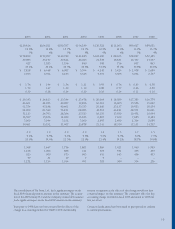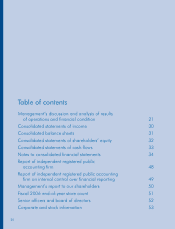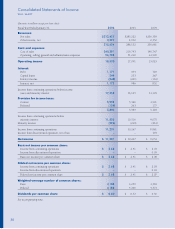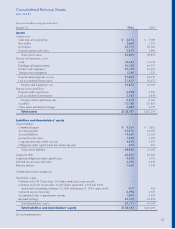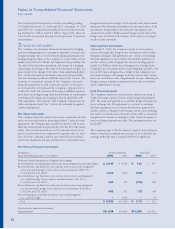Walmart 2006 Annual Report Download - page 31
Download and view the complete annual report
Please find page 31 of the 2006 Walmart annual report below. You can navigate through the pages in the report by either clicking on the pages listed below, or by using the keyword search tool below to find specific information within the annual report.
29
to period. These factors could cause management to conclude that
impairment indicators exist and require that impairment tests be
performed, which could result in management determining that the
value of long-lived assets is impaired, resulting in a writedown of the
long-lived assets.
Goodwill is not amortized, but is evaluated for impairment annu-
ally or whenever events or changes in circumstances indicate that
the value of certain goodwill may be impaired. This evaluation
requires management to make judgments relating to future cash
fl ows, growth rates, and economic and market conditions. These
evaluations are based on discounted cash fl ows that incorporate the
impact of existing Company businesses. Historically, the Company
has generated suffi cient returns to recover the cost of goodwill and
other intangible assets. Because of the nature of the factors used in
these tests, if different conditions occur in future periods, future
operating results could be materially impacted.
Income Taxes
The determination of our provision for income taxes requires sig-
nifi cant judgment, the use of estimates, and the interpretation and
application of complex tax laws. Signifi cant judgment is required
in assessing the timing and amounts of deductible and taxable
items. We establish reserves when, despite our belief that our tax
return positions are fully supportable, we believe that certain
positions may be successfully challenged. When facts and circum-
stances change, we adjust these reserves through our provision
for income taxes.
Self-Insurance
We use a combination of insurance, self-insured retention and
self-insurance for a number of risks, including, without limita-
tion, workers’ compensation, general liability, vehicle liability and
the Company’s portion of employee-related health care benefi ts.
Liabilities associated with the risks that we retain are estimated
in part by considering historical claims experience, including fre-
quency, severity, demographic factors, and other actuarial assump-
tions. In calculating our liability, we analyze our historical trends,
including loss development, and apply appropriate loss develop-
ment factors to the incurred costs associated with the claims made
against our self-insured program. The estimated accruals for these
liabilities could be signifi cantly affected if future occurrences or
loss development differ from these assumptions. For example, for
workers’ compensation and liability, a 1% increase or decrease to
the assumptions for claims costs and loss development factors
would increase or decrease our self-insurance accrual by $23 mil-
lion and $62 million, respectively.
For a summary of our signifi cant accounting policies, please see
Note 1 to our consolidated fi nancial statements that appear after
this discussion.
Forward-Looking Statements
This Annual Report contains statements that Wal-Mart believes
are “forward-looking statements” within the meaning of the
Private Securities Litigation Reform Act of 1995. Those state-
ments are intended to enjoy the protection of the safe harbor for
forward-looking statements provided by that Act. These for-
ward-looking statements include statements under the caption
“Results of Operations” regarding the effect of the opening of new
stores on existing stores’ sales and the trend in the percentages
that the net sales of certain of our business segments represent
of our total net sales, under the caption “SAM’S CLUB Segment”
regarding the improvement in net sales in the SAM’S CLUB
Segment and under the caption “Liquidity and Capital Resources”
in Management’s Discussion and Analysis of Financial Condition
and Results of Operations with respect to our capital expenditures,
our ability to fund certain cash fl ow shortfalls by the sale of com-
mercial paper and long-term debt securities, our ability to sell our
long-term securities and our anticipated reasons for repurchasing
shares of our common stock. These statements are identifi ed by the
use of the words “anticipate,” “believe,” “contemplate,” “expect,”
“plan,” and other, similar words or phrases. Similarly, descriptions
of our objectives, strategies, plans, goals or targets are also forward-
looking statements. These statements discuss, among other things,
expected growth, future revenues, future cash fl ows, future capital
expenditures, future performance and the anticipation and expec-
tations of Wal-Mart and its management as to future occurrences
and trends. These forward-looking statements are subject to cer-
tain factors, in the United States and internationally, that could
affect our fi nancial performance, business strategy, plans, goals and
objectives. Those factors include the cost of goods, labor costs, the
cost of fuel and electricity, the cost of healthcare benefi ts, insur-
ance costs, catastrophic events, competitive pressures, infl ation,
accident-related costs, consumer buying patterns and debt levels,
weather patterns, transport of goods from foreign suppliers, cur-
rency exchange fl uctuations, trade restrictions, changes in tariff and
freight rates, changes in tax and other laws and regulations that
affect our business, the outcome of legal proceedings to which
we are a party, unemployment levels, interest rate fl uctuations,
changes in employment legislation and other capital market, eco-
nomic and geo-political conditions. Moreover, we typically earn a
disproportionate part of our annual operating income in the fourth
quarter as a result of the seasonal buying patterns. Those buying
patterns are diffi cult to forecast with certainty. The foregoing list of
factors that may affect our performance is not exclusive. Other fac-
tors and unanticipated events could adversely affect our business
operations and fi nancial performance. We discuss certain of these
matters more fully, as well as certain risk factors that may affect our
business operations, fi nancial condition and results of operations,
in other of our fi lings with the SEC, including our Annual Report
on Form 10-K. We fi led our Annual Report on Form 10-K for the
year ended January 31, 2006, with the SEC on or about March 29,
2006. Actual results may materially differ from anticipated results
described or implied in these forward-looking statements as a result
of changes in facts, assumptions not being realized or other circum-
stances. You are urged to consider all of these risks, uncertainties
and other factors carefully in evaluating the forward-looking state-
ments. The forward-looking statements included in this Annual
Report are made only as of the date of this report, and we under-
take no obligation to update these forward-looking statements
to refl ect subsequent events or circumstances, except as may
be required by applicable law.


